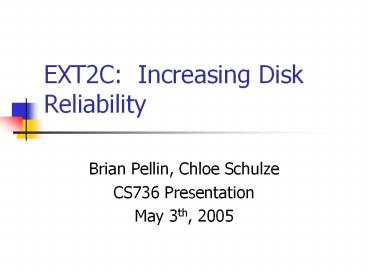EXT2C: Increasing Disk Reliability - PowerPoint PPT Presentation
Title:
EXT2C: Increasing Disk Reliability
Description:
EXT2C: Increasing Disk Reliability. Brian Pellin, Chloe Schulze. CS736 Presentation ... (Partial) Solution: Checksum the data to verify correctness before ... – PowerPoint PPT presentation
Number of Views:88
Avg rating:3.0/5.0
Title: EXT2C: Increasing Disk Reliability
1
EXT2C Increasing Disk Reliability
- Brian Pellin, Chloe Schulze
- CS736 Presentation
- May 3th, 2005
2
Introduction
- Problem Disks can fail silently, corrupting
data - (Partial) Solution Checksum the data to verify
correctness before returning data to the user - (This does not recover lost data, but at least
the user knows the data is bad.)
3
Approach
- Implement checksumming within EXT2
- New read/write functions
- Wrap new functionality around existing functions
- New error code
4
Conclusion Summary
- Implemented working checksumming on top of EXT2
- Achieves added safety at the cost of additional
overheads
5
Outline
- Fault Model
- EXT2C
- Performance
- Conclusions
6
Fault Model
- Fail Stop all or nothing
- No longer adequate for todays disk failures
- Partial Failure
- Latent sector errors
- Misdirection right data written to wrong
location - Phantom writes disk returns okay, but data was
not written - Malicious writes
7
Relating Fault Model to Implementation
- Partial Failure suggests
- Detection
- Notification
- Verification of data
- Backup or replication to avoid data loss
8
Outline
- Fault Model
- EXT2C
- Performance
- Conclusions
9
EXT2C
- EXT2 base file system
- Modifications
- Checksum file data
- New read/write functions to implement the
checksumming - New error code to notify user of data corruption
10
Checksums
- Checksum computed per block of a file
- One checksum file per inode
- Named for files inode number
- 20 bytes long (fixed length)
- Computed by the hash function SHA-1
11
Checksum Creation
foo.c
5 (Checksum file)
inode no. 5
0
0
20
4096
SHA-1
Block no. 1
12
Ext2C_file_read
- Normal file read
- Open checksum file
- Calculate blocks read
- For each block being read
- Read in block
- Compute checksum
- Read in old checksum
- Compare if not equal, return error
- Close checksum file
- Return result
13
Read Operation
Read 4000 bytes
2000
6000
- Read Data From File
- Read overlapping data block
- Read corresponding section of checksum file
- Hash Data and Compare with stored checksum
- Repeat for other blocks overlapped by read
Hash
Match or Failure
?
Checksum File
14
Ext2c_file_write
- Normal file write
- Calculate blocks changed
- Open checksum file
- For each changed block
- Read in block
- Compute checksum
- Write checksum to checksum file
- Close checksum file
- Return result of normal file write
15
Targeted Problems
- Detect
- Silently corrupted data
- Partially Detect
- Phantom writes
- Misdirection
- Malicious write
16
Outline
- Fault Model
- EXT2C
- Performance
- Conclusions
17
Correctness
- Able to run PostMark and additional benchmarks
without encountering any errors - Injected errors are detected and our error code
is returned
18
EXT2 vs. EXT2C Test Outline
- Microbenchmarks
- Measure cold cache small reads/writes
- Warm Cache small reads
- Benchmarks capturing larger scale behavior
- PostMark
- Large sequential reads
19
Cold cache read/write Comparison
- We time the differences between ext2 and ext2c
on - Single block reads
- Single block writes
- 10 block reads
- 10 block writes
20
(No Transcript)
21
Warm cache comparison
- What overhead does ext2c add when data is cached
in memory?
22
(No Transcript)
23
EXT2 vs. EXT2C Test Outline
- Microbenchmarks
- Measure cold cache small reads/writes
- Warm Cache small reads
- Benchmarks capturing larger scale behavior
- PostMark
- Large sequential reads
24
PostMark
- Benchmark crafted to simulate realistic small
file workloads - Intersperses read/write/append operations
- Measures throughput (transactions per second)
25
PostMark Results (Transactions per second)
26
Large Sequential Reads
- Desire
- Check summing costs will be amortized over long
operations
27
(No Transcript)
28
Outline
- Fault Model
- EXT2C
- Performance
- Conclusions
29
Conclusions
- Benefit notification of data corruption, no
longer mistake bad or wrong data for good data - Cost overhead of checksum computation and extra
I/O costs - Throughput is halved on small file workloads
- Sequential I/O amortizes some overhead
30
Further Work
- Optimizations
- Open/close the checksum when the file is opened
and closed - Batch checksum creation at time of file system
creation - Ensuring that checksum data blocks are near file
blocks to reduce seeking
31
References/Influences
- DesAutels, P. SHA 1 Secure Hash Algorithm.
www.w3.org/PICS/DSig/SHA1_1_0.html 1997 - Patil, S., Kashyap, A., Sivanthanu, G., Zadok, E.
I3FS An In-Kernel Integrity Checker and
Intrusion Detection File System
http//www.fsl.cs.sunysb.edu/docs/i3fs/i3fs.html
2005. - Prabhakaran, V., Agrawal, N., Bairavasundaram,
L., Gunawi, H., Arpaci-Dusseau, A.,
Arpaci-Dusseau, R. IRON File Systems. Draft
2005 - Sivanthanu, G., Wright, C., Zadok, E. Enhancing
File System Integrity Through Checksums.
Technical Report FSL-04-04 2004. - Stein, C., Howard, J., Seltzer, M. Unifying File
System Protection, Proceedings of the 2001 USENIX
Annual Technical Conference 2001 - Weinberg, G. Solaris Dynamic File System. Sun
Microsystems Presentation

